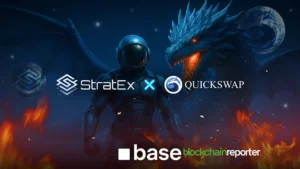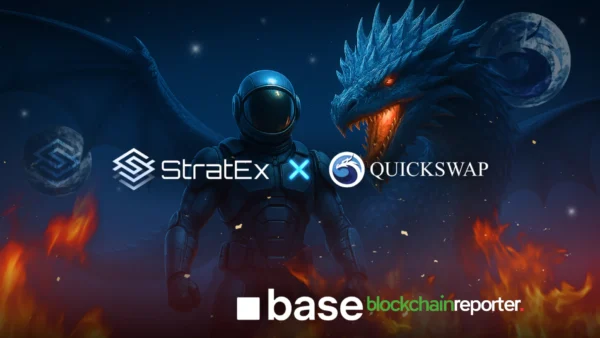
In the dynamic realm of blockchain innovation, Router Protocol emerges as a trailblazing force, dedicated to dismantling barriers and fostering seamless communication between diverse blockchain networks. As we sit down with Ram Ramachandran, the esteemed CEO and Co-founder of Router Protocol, this exclusive interview unveils the intricate details of the project’s mission, its strategic contributions to the blockchain ecosystem, and its visionary approach to addressing the evolving challenges of Web3 adoption.
Join us on this insightful journey as we explore the nuances of Router Protocol’s commitment to Bitcoin interoperability, user privacy, and security, and its groundbreaking “no TVL approach,” shaping the landscape of cross-chain technology and the future of decentralized applications (dApps).
Q1. To begin, can you please provide our readers with an overview of Router Protocol and its mission in the ever-evolving blockchain landscape? How did your journey lead you to become the CEO of Router Protocol?
I am Ramani Ramachandran, an MIT alumni and CEO and co-founder of Router Protocol, and I have been a serial entrepreneur in the Fintech and digital assets space for the better part of a decade. I built and ran Asia’s earliest crypto fund, returning 4x; built Fordex, the world’s first stable coin DEX, and Qume, an institutional-grade crypto exchange. I also launched Asia’s first crypto-index token before starting Router Protocol.
Router Protocol is an infrastructure enterprise enabling communication between blockchains. Backed by Coinbase Ventures, QCP, Shima Capital, Wintermute, CoinDCX Ventures, MapleBlock, De-Fi Capital and Polygon, its mission is to increase Web3 adoption by solving existing problems in cross-blockchain communications, such as security, scalability, decentralization, and a lack of true-blue cross-chain dApps.
In February 2023 Router pioneered the third generation of interoperability technology with the launch of V2 featuring Router Chain, a secure, scalable, modular, composable framework for cross-blockchain interoperability. Web3 projects can utilize four core frameworks of Router V2 to customize their cross-chain needs, including building dApps that are interoperable by default. Router’s Gen III infrastructure is ushering in a new era of blockchain interoperability, creating a common standard platform for all blockchain ecosystems to communicate with each other.
Q2. Bitcoin interoperability is a significant aspect of Router Protocol’s offering. Can you explain how the platform facilitates interoperability with Bitcoin and what benefits this brings to the broader blockchain ecosystem?
DeFi growth is being slowed by Bitcoin’s lack of interoperability, as well as other challenges. A growing number of concerns arise regarding interoperability with other blockchain protocols. Router Protocol has partnered with Rootstock on its V1 environment to support seamless asset transfers by eliminating the need to rely on centralized exchanges that have security vulnerabilities and higher transaction costs.
Rootstock is a Bitcoin sidechain offering EVM-compatible smart contracts to the Bitcoin ecosystem. By combining Bitcoin hash power with Merge mining, you will be able to maximize security and mining. With Router Protocol, stablecoins can be seamlessly transferred between Rootstock integration and other supported blockchains. Initially, it increased interoperability and expanded the utility of digital assets.
Developers can create unique applications and create a more vibrant Web3 space through this integration, which enhances Bitcoin interoperability and unlocks opportunities for dApps and DeFi Protocols. Bitcoin interoperability will bring multiple advances to the crypto space, one of the most important being shared liquidity. Currently, liquidity is fragmented across the industry, but true interoperability allows smaller DeFi tokens to take advantage of the deep liquidity within Bitcoin and other top coins.
Q3. In envisioning onboarding the next billion users into the blockchain ecosystem, how does Router Protocol plan to remove inter-chain barriers and foster collaboration among different ecosystem communities?
With Router Protocol, we are removing inter-chain barriers and fostering collaboration among different ecosystem communities. To bridge the gap between siloed ecosystems, an asset transfer bridge was created early on. As Router evolved, a Layer 1 blockchain, Router Chain, was developed, based on the Tendermint Consensus of Cosmos, leading to the concept of IDapps (interoperable dApps).
Router Protocol seeks to provide a composable solution for interoperability, making it easier for the next billion users to join the blockchain ecosystem through these technological advancements. We’re also working on building intent based solutions for Web3 adoption.
Q4. With privacy and security being crucial concerns in the blockchain space, how does Router Protocol address and enhance user privacy and security within its cross-chain solution?
Router Protocol employs a robust security mechanism. Also, our cross-chain asset transfer bridge, Nitro, ensures the safety of user funds by ensuring that the forwarder can claim them only once the transaction is successfully settled on the destination chain and the settlement transaction is verified on the Nitro middleware contract. This mechanism eliminates any incentive for forwarders to engage in malicious activities, providing users with robust security.
Q5. Looking ahead to 2024, what security solutions does Router Protocol envision for the broader blockchain ecosystem, considering the evolving threats and challenges?
Due to the increased vulnerability of bridges to hacking, Router Protocol is taking proactive measures by constructing its own Layer 1 blockchain, known as Router Chain. This blockchain is built upon the Tendermint Consensus of Cosmos, enhancing its security and resilience.
Q6. The concept of a “no TVL approach” is intriguing. Can you explain how Router Protocol is implementing this approach and what benefits it brings to users and the overall blockchain community?
Router Protocol’s “no TVL approach” tackles critical issues tied to unsustainable liquidity mining campaigns and the vulnerability of bridges in handling large Total Value Locked (TVL). Many existing bridges heavily rely on user-sourced liquidity through unsustainable mining efforts, posing a risk to the project’s long-term sustainability as it bears the cost of such campaigns.
Additionally, the “Honey Pot Problem” arises from the lack of maturity in current bridges to handle substantial TVL, jeopardizing not only their security but also the integrity of the entire liquidity base in case of security breaches in interconnected bridges. In contrast, Router Protocol’s “no TVL approach” ensures financial stability by avoiding reliance on unsustainable campaigns and enhances security, contributing to a more resilient and sustainable cross-chain ecosystem. Also, the liquidity is fronted by forwarders which is why no TVL locked
This approach benefits users by instilling confidence in the protocol’s stability and contributes to the broader blockchain community by prioritizing long-term viability over short-term gains. Router Protocol’s commitment to these principles establishes a foundation for a robust and enduring infrastructure for cross-chain transactions. This dynamic on-demand TVL approach is also part of the overall ‘intents’ based approach that we are pioneering with cross-chain messaging and bridging
Q7. How does Router Protocol stay ahead of technological advancements and industry trends to continually improve its cross-chain solution and adapt to the evolving needs of the blockchain community?
Router Protocol employs a forward-thinking strategy to proactively stay ahead of technological advancements and industry trends, ensuring a continual enhancement of its cross-chain solution and adaptability to the evolving needs of the blockchain community. Router Protocol is working on an intent-based framework for fostering Web3 adoption, prioritizing a seamless integration experience for developers. An emphasis on cost-effectiveness is maintained, ensuring that the associated benefits are accessible without imposing financial burdens.
In addition, Router Protocol actively collaborates with industry leaders, establishing strategic partnerships that contribute to its growth and success. Through these concerted efforts, Router Protocol positions itself as a dynamic and responsive player in the blockchain space, consistently delivering innovative solutions that align with the ever-changing landscape and requirements of the blockchain community.
Q8. Can you provide some insights into the roadmap of Router Protocol? Are there any upcoming developments or partnerships that you can share with us to give us a glimpse of what’s next for the project?
Router does have some very big things planned for the year ahead, like continuing to innovate and drive adoption of cross-chain technology, the launch of new products, Router Protocol’s Intent-Based Framework, and building on top of our deep partner bench. We look forward to growing in each of these areas and are excited for 2024!
Q9. As we conclude our conversation, what are your long-term visions and goals for Router Protocol in the next few years, and how do you foresee the broader blockchain industry evolving during this time? Is there a message or key takeaway you’d like to share with our readers regarding the future of cross-chain technology and Web3?
We believe we can onboard the next one billion users to the blockchain space through cross-chain technology, making it simple for developers to create easy-to-use applications and build useful tools. We see the blockchain space growing exponentially over the next few years, with interoperability being the “main character” for a long time. Blockchain is amazing technology, but the details of the chains can be and should be abstracted out from an end user and a developer’s perspective.
Interview Summary
In this illuminating exploration of Router Protocol’s visionary mission and groundbreaking contributions, our conversation with Ram Ramachandran has shed light on the dynamic landscape of blockchain innovation. Router Protocol’s strategic initiatives, such as the construction of the secure Router Chain and the intent-based framework for Web3 adoption, underscore the project’s proactive stance in addressing evolving challenges.
The commitment to financial stability through the “no TVL approach” not only benefits users but also contributes to the sustainability and resilience of the broader blockchain community. As we peer into the future, Router Protocol’s roadmap promises exciting developments, including new products and the highly anticipated Intent Based Framework. Ramachandran’s vision for onboarding the next billion users to the blockchain space through cross-chain technology reflects a commitment to simplicity and accessibility for both developers and end-users.
In concluding our conversation, Ramachandran paints a picture of the blockchain space’s exponential growth over the next few years, with interoperability taking center stage as the “main character.” The belief that the intricate details of blockchain chains should be abstracted for both users and developers reflects a dedication to user-friendly experiences in the decentralized realm.
Router Protocol stands as a beacon in the ever-evolving blockchain landscape, and as we look forward to 2024, the project’s commitment to innovation, collaboration, and user-centric design positions it as a key player in shaping the decentralized tomorrow. Through the words of Ram Ramachandran, we glimpse not only the trajectory of Router Protocol but also the transformative potential of cross-chain technology and Web3 in redefining the landscape of decentralized possibilities.









